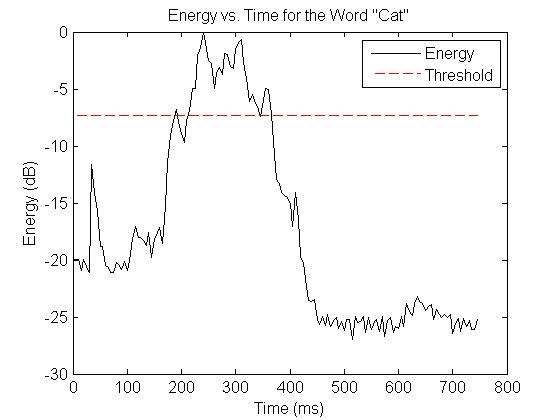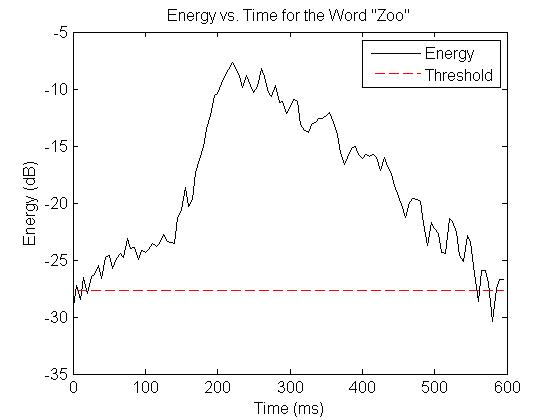| << Chapter < Page | Chapter >> Page > |
The syllable detection algorithm takes as its input recorded speech and produces an output matrix denoting the start and end times of each syllable in the recording. There are two main parts to the algorithm. First, each sound in the input file must be classified as a vowel, consonant, or noise. Second, the algorithm must determine which sequences of sounds correspond to valid syllables.
The sound classification step splits the input signal into many small windows to be analyzed separately. The classification of these windows as vowels, consonants, or noise relies on two core characteristics of the signal: energy and periodicity. Vowels stand out as having the highest energy and periodicity values, noise ideally has extremely low energy, and consonants are everything that falls between these two extremes.
The energy of a window of the input vector W is calculated as
E = |W|^2.
However it is necessary to set general energy thresholds that are valid for speech samples of varying volume. In order to accomplish this, after the energies of all the windows have been calculated, they are converted into decibels relative to the maximum energy value.
E' = 10*log10(E/max(E)).
The energy thresholds are then defined in terms of a percent of the total energy range. For example, if an energy threshold was 25 percent and the energies ranged from -100 to 0 dB, then everything from -25 to 0 dB would be above the threshold.
In some cases, energy alone is enough to determine whether a certain sound is a vowel, consonant, or noise. For instance, here is a plot of the energy vs. time of a recording of the spoken word "cat." It is easy to tell which portions of the figure correspond to vowels, consonants, and noise by inspection:

However, energy cannot always separate vowels and consonants so dramatically. For example, the word "zoo."

Although a portion of the vowel still has significantly higher energy than the consonant, the ending portion of the vowel drops in energy to the point where it is dangerously close to the threshold. Raising the threshold so that the "z" sound is certain not to be counted as a vowel only makes it more likely that portions of the "oo" sound will be mistakenly classified as consonants. Clearly, additional steps are necessary to more accurately differentiate between consonants and vowels.
The algorithm uses the periodicity of the signal to accomplish this task. The periodicity is obtained using the autocovariance of the window being analyzed. This is calculated as:
C(m) = E[(W(n+m)-mu)*conj(W(n)-mu)]
Mu is the mean of the window W. It measures how similar the signal is to itself at shifts of m samples and can therefore distinguish periodic signals from aperiodic ones due to their repetitive nature. The autocovariance vector is most stable and therefore most meaningful for values of m relatively close to 0, since for larger m, fewer samples are considered, causing the results to become more random and unreliable. Therefore, the sound classification algorithm only considers autocovariance values with m less than 1/5 the total window size. These autocovariance values are normalized so that the value at m = 0 is 1, the largest possible value. The maximum autocovariance in this stable region is considered the periodicity of the window.

Notification Switch
Would you like to follow the 'Speak and sing' conversation and receive update notifications?